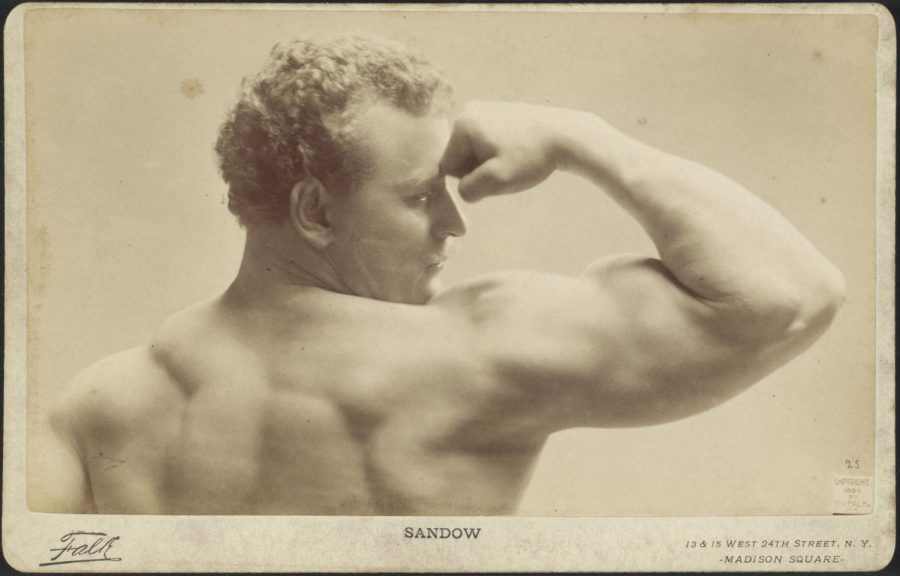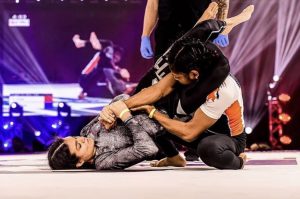#FitTok’s Ancient Roots
The history of bodybuilding and the danger posed by contemporary fitness ideals
COURTESY OF CREATIVE COMMONS
Eugen Sandow was a world-renowned bodybuilder who spearheaded the modern sport.
May 4, 2022
If you are on the fitness-focused side of TikTok, known as #FitTok, odds are the algorithm shows you video after video of extremely muscular people recommending workout plans designed to help viewers achieve a certain body aesthetic. Most creators label this content as #bodybuilding. The hashtag is the fourth most used fitness hashtag on the app. In fact, it racked up more than 28 billion views as of May 3.
The popularization of bodybuilding among casual gym-goers is the latest evolution of the sport.
When most people think of modern bodybuilding, they picture tanned, towering, muscular men like Arnold Schwarzenegger who compete by flexing in Speedos. Modern iterations illustrate significant changes from when bodybuilding began.
While competitive bodybuilding originated in the 1930s, the sport can be traced back to ancient Greece and India. Similar to how #FitTok influencers highly value body aesthetics, ancient Greeks utilized a crude form of resistance training to shape their bodies in a way that resembled their sculptures’ ideal physiques.
India utilized their own form of training dating back to the 11th century. They intentionally lifted stone weights called “nals” — the ancient equivalent of dumbbells. The amount of weight lifted then became the measure of a bodybuilder’s progress rather than aesthetics.
Emphasis on strength within the community continued into the early 19th century, when traveling strongmen attempted to outlift each other in the earliest informal weightlifting contests during the 1800s. The public watched contestants pull carts and lift animals until one man could not lift more than the other. Physique played no role in determining the winner. Most competitors actually displayed high body fat levels with protruding stomachs due to unhealthy eating habits.
The Amateur Athletic Union created the first official bodybuilding competition, Mr. America, in 1939.
One strongman, Eugen Sandow, led the shift back toward Greek aesthetics in the 1890s. Known for his symmetrical and densely muscular physique, Sandow is considered by many to be the father of modern bodybuilding. His book published in 1904, “Body Building Or Man in the Making,” gave the sport its name.
The period between 1930 and 1970 is known as the golden era in the history of bodybuilding. The Amateur Athletic Union created the first official bodybuilding competition, Mr. America, in 1939. Mr. Universe in 1950 and Mr. Olympia in 1965 were the first worldwide events.
Due to the increased popularity of these competitions in the 1970s, winners like Arnold Schwarzenegger, who won Mr. Olympia five years in a row, became household names and made muscular bodies more desirable among the general population.
This body type became even more muscular after the 1970s when lifters began increasingly using anabolic steroids, growth hormones and insulin in response to an increased emphasis on size in competitions.
Dorian Yates, who won six consecutive Mr. Olympia titles, became the model for this new bodybuilding era. He dominated during the 1990s by setting new size standards. His size eventually earned him the nickname “The Shadow.” Yates’ stature was not naturally achievable for all competitors, which pushed many to use steroids to try and keep up.
Despite its popularity, bodybuilding is not yet an Olympic event due to the frequent use of performance-enhancing drugs. Moreover, the extremely low body fat percentage expected of competitive bodybuilders is dangerous for their health.
One famous bodybuilder, Andreas Munzer, died of multiple organ failure as a result of years of alleged anabolic steroid use and nearly zero percent body fat. Despite his untimely death in 1996 at the age of 31, pictures of Munzer as well as his profile, frequently go viral on bodybuilding forums.
For men, the obsession with size and shredded muscles also translates to high rates of muscle dysmorphia, otherwise known as bigorexia within the bodybuilding community. Bigorexia is when “individuals obsess about being inadequately muscular,” according to a 2008 study by Dr. Philip Mosley. Bigorexia can have a number of negative effects.
Although many today are focused on their appearances, it is important to note the emphasis on strength throughout the history of bodybuilding.
Get the latest Fordham sports updates on your Twitter feed. Follow The Observer’s sports Twitter page here.















